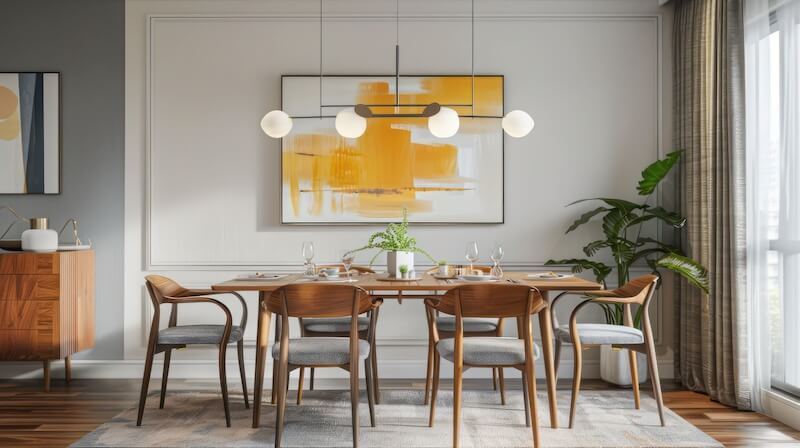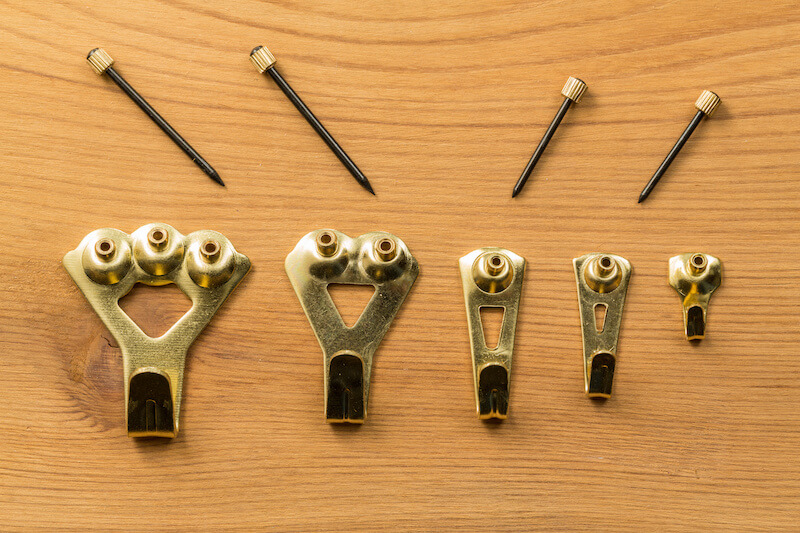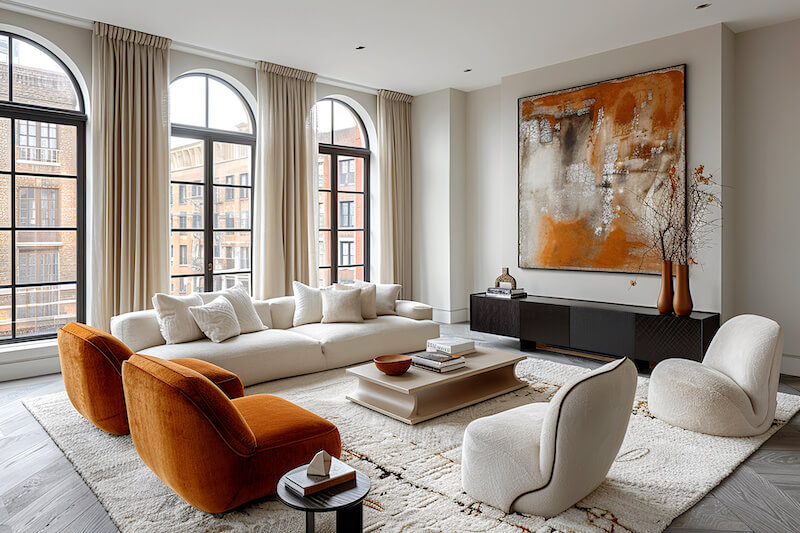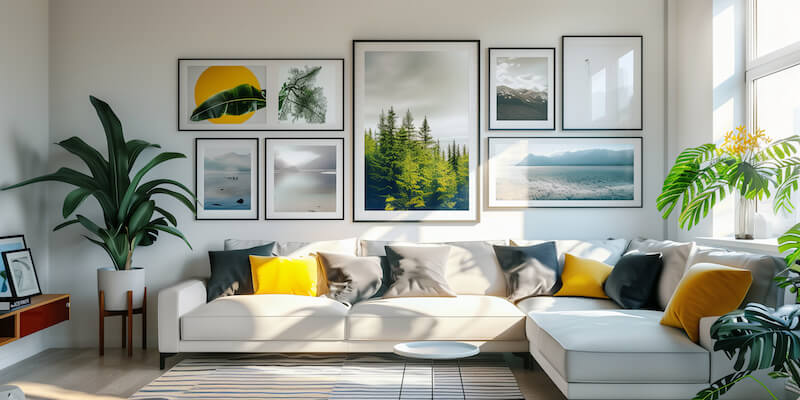Decorating with large art makes a dramatic statement in any room. If you’re struggling to fill a blank wall, an extra-large frame covers plenty of space without creating clutter. Additionally, big art establishes a clear focal point that’s sure to impress. Master decorating with large artwork by choosing the right piece, hanging it correctly, and filling the surrounding space with thoughtful finishing touches.
3 Quick Tips For Decorating With Large Art
- Choose large artwork that complements your room’s theme and color palette to create harmony.
- Use secure hanging techniques like wall studs, D-rings, and two hooks for stability and safety.
- Maintain clarity in your design by balancing the area around large art with other elements and avoiding visual clutter.
Choosing the Right Piece: Match Your Theme & Colors

The artwork you choose should match your room’s overall theme and style. A large piece of abstract artwork could be a perfect match if you’re following a modern design strategy. A more rustic room might call for impressionist landscapes, farmland portraits, or botanical prints. An eclectic space can mix and match to create well-planned contrast.
Another important aspect is the color scheme. For visual harmony, artwork should complement or contrast the room’s existing colors. For example, artwork with warm yellow hues can stand out in a room with cool blue tones. Complementary colors that exist on opposite sides of the color wheel bring out the best in each other. If you’re decorating a grey living room, look for art with colors that make a powerful accent.
Tips For Hanging Large Art

Mark the Right Hanging Height First
Hanging large artwork at the right height is crucial for visual appeal. Typically, the center should be positioned 60 to 63 inches from the floor, slightly higher than the general rule of 57-60 inches, to be well-framed within the room’s layout.
Consider the furniture placement, too. Ideally, the bottom of the frame should be 6 to 12 inches above the top of your furniture, creating a pleasing aesthetic and preventing the art from appearing cramped or out of place.
Weight Considerations
Weight is a significant factor when choosing large art. Large framed prints are typically heavier than stretched canvas prints.
Most oversized art is unsuitable for non-damaging hanging methods like command strips. Brands like 3M have a maximum frame size limit of 24 by 36 inches, regardless of weight, due to the difficulty of ensuring even weight distribution.
Better options for heavy pieces of art include:
- Finding a Wall Stud Attach the hanging bracket or hook to a wall stud to provide secure support for heavy artwork. Wall studs are strong enough to hold the weight of large pieces.
- Drywall Anchors Use drywall anchors to secure your artwork effectively if no wall stud is available. Choose anchors rated for the weight of your piece for reliable support. For art hung on brick walls, consider using masonry anchors or screws designed specifically for those surfaces.
- Heavy Duty Hanging Hooks Heavy-duty hanging hooks have a broader base and more supporting nails than traditional hanging hooks.
- D-Rings D-rings are metal loops in the shape of a “D” that are securely attached to the back of a frame. Securely attach D-rings to the back of the frame, positioning them about one-third down from the top at a 45-degree angle to ensure proper support and balance.
- 1/8″ Hanging Wire Opt for heavy-duty or stainless steel wire for heavier artwork; these types can typically support more than 300 pounds. Use hanging wire to allow flexibility in positioning and make small adjustments for level and balance.
How to Hang Art on a Staircase Wall
Tall open spaces like staircase walls are perfect for large artwork. To find the ideal hanging height, stand on one step, look straight at the wall, and mark the point directly in front of your line of vision. This is where the center of your piece should go.
Securely anchor the artwork with heavy-duty hooks or wall anchors, considering its weight and size. If the artwork is especially large, make sure you have a helper to hold it in place while you mount it. If you need a ladder, a tool called a ladder leveler is designed to keep the ladder stable across multiple steps.
Hanging art on the staircase’s landing can be a better choice for large pieces. It provides a flat, centralized space to showcase the artwork at eye level, creating a dramatic focal point without competing with the staircase’s incline.
Achieving Balance: What to Put on Either Side of Large Art

When displaying a large artwork, the surrounding space enhances its visual impact. Adding complementary decor on either side can create balance and draw attention to the centerpiece without overwhelming it. Thoughtful additions can frame the large piece beautifully and complete the space’s overall aesthetic.
Here are a few unique ways you can decorate either side of a large painting:
- Wall Sconces – Add lighting to highlight the artwork and create ambiance.
- Small Framed Art – Use complementary or contrasting smaller pieces for a gallery effect.
- Decorative Shelves – Display plants, books, or small sculptures for added texture.
- Tall Vases or Planters – Incorporate greenery or floral arrangements for natural elegance.
- Mirrors – Reflect light and expand the sense of space while adding symmetry.
- Floating Shelves – Showcase curated decor, such as candles, pottery, or personal keepsakes.
- Wall Hooks with Hanging Decor – Add texture with hanging baskets, textiles, or ornaments.
- Sculptural Wall Art – Opt for minimalist metal or wood accents for depth and dimension.
- Tall Candlesticks or Lanterns – Add vertical elements to nearby surfaces that draw the eye upward.
- Accent Furniture – Place a small console table or bench beneath the artwork for added functionality and stylish layers.
Gallery Walls with Large Pieces

Making a gallery wall around a large piece of art can create dynamic and harmonious energy.
Try mixing large, medium, and small art pieces to create a harmonious look that draws the eye around the room. Incorporating different mediums, such as mirrors and sculptural pieces, alongside one large piece of art enhances the dimensionality of a room.
If you’re feeling adventurous, you can vary the orientation of artworks, such as mixing vertical and horizontal pieces. This balance of sizes and orientations creates an engaging gallery wall, showcasing large art alongside smaller pieces.
Maintenance & Care for Large Artwork
Maintaining and caring for large artwork ensures its longevity and visual appeal. Quality framing is crucial for traditional prints and can be a nice touch for canvas prints. Regular cleaning prevents dust accumulation, impacting the artwork’s appearance and longevity.
Controlling temperature, humidity, and sun exposure will prevent damage, such as warping or cracking. Handle artworks carefully to avoid physical damage, especially when moving or storing them.
Are You Ready to Decorate Your Home With Large Art?
Decorating with large art can transform your spaces, creating stunning focal points and enhancing your room’s overall design. From choosing the right artwork and understanding weight considerations to mastering hanging techniques and balancing elements, this guide provides everything you need to know. Remember to maintain your art properly to keep it looking its best. With these tips, your home will be a masterpiece of artful design.




